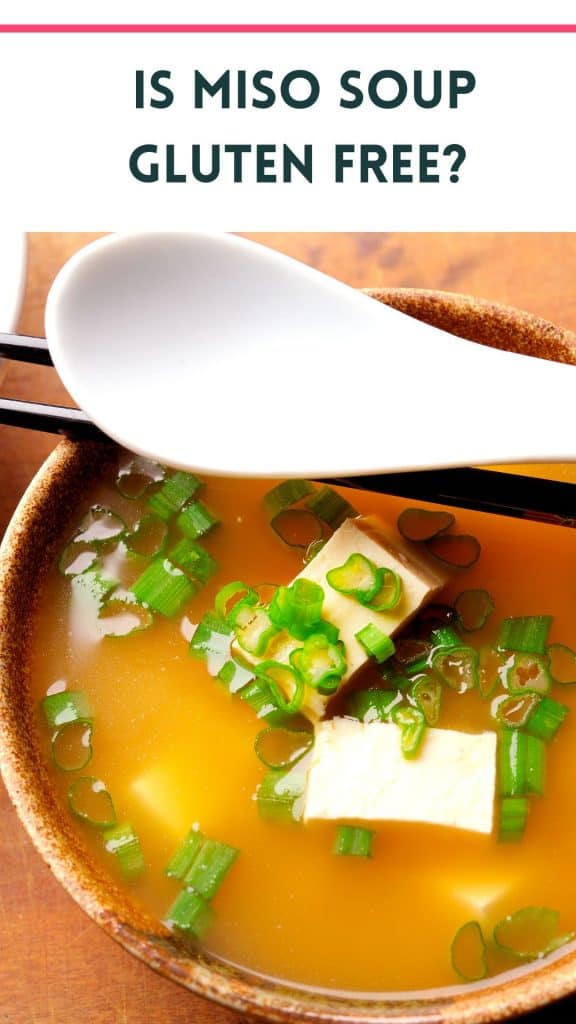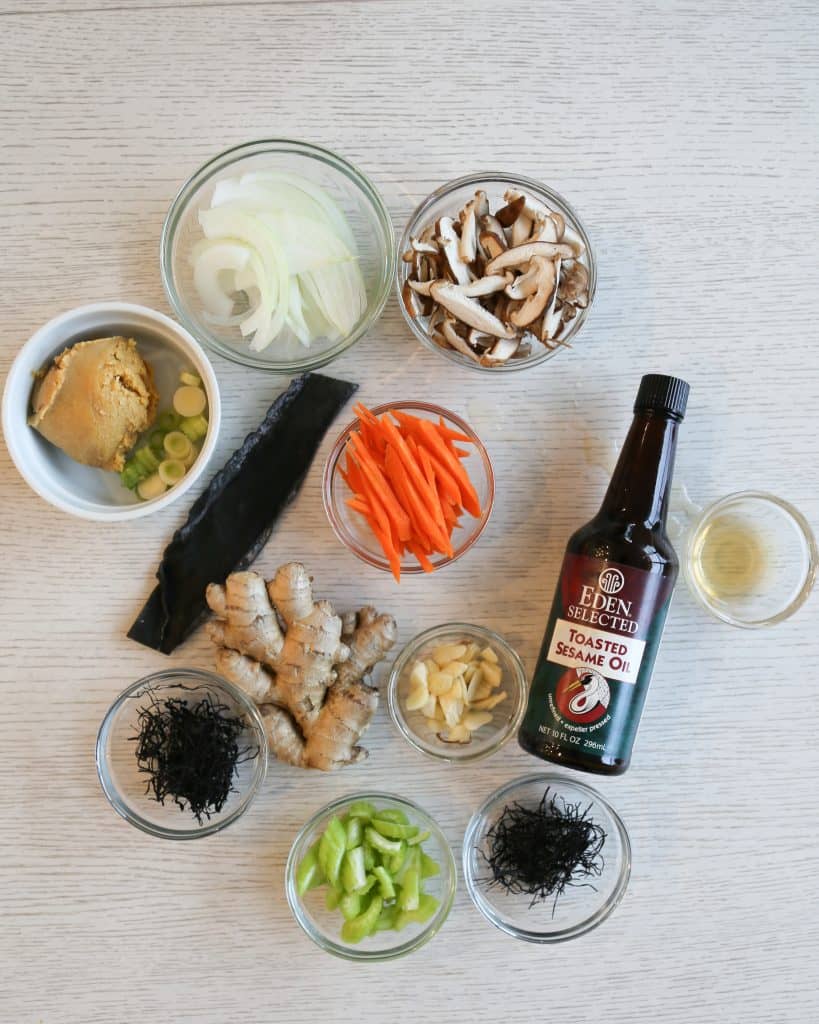Is Miso Soup Gluten Free?
If you’re on a gluten free diet or have celiac disease eating at a Japanese restaurant can be confusing. One of the questions you may ask yourself is, “Is miso soup gluten free?”
Quick Answer: Miso soup is usually not gluten free because the miso used to make the soup could have gluten depending on what the miso paste was fermented from. If the miso was fermented from wheat it is not gluten free. Miso is a fermented paste that uses many types of beans, as well as grains like rice, amaranth, chickpeas, soy, or millet, which are all naturally gluten free.

Some varieties of miso paste use wheat, barley, and rye, which are all gluten containing grains. So whether or not miso soup is gluten free depends on what the original miso was fermented from.
This post may contain affiliate links. As an Amazon Associate I earn from qualifying purchases at no cost to you. See my Affiliate Disclosure to read my policy and more about affiliate links.
Table of Contents
- Is Traditional Miso Soup Gluten Free?
- Does Miso Soup Have A Lot Of Gluten?
- Does Miso Soup Have Gluten or Dairy?
- Why Does Miso Have Gluten In It?
- Best Gluten Free Miso Alternatives
- What Kind of Miso Is Gluten Free
- How to Make Gluten Free Miso Soup At Home
- Is Miso Soup Keto?
- Can You Freeze Miso Soup?
- How To Freeze Miso Soup
- How to Reheat Miso Soup?
- Is Soy Sauce Gluten Free?
- What Are Gluten Free Japanese Dishes?
Table of Contents
- Is Traditional Miso Soup Gluten Free?
- Does Miso Soup Have A Lot Of Gluten?
- Does Miso Soup Have Gluten or Dairy?
- Why Does Miso Have Gluten In It?
- Best Gluten Free Miso Alternatives
- What Kind of Miso Is Gluten Free
- How to Make Gluten Free Miso Soup At Home
- Is Miso Soup Keto?
- Can You Freeze Miso Soup?
- How To Freeze Miso Soup
- How to Reheat Miso Soup?
- Is Soy Sauce Gluten Free?
- What Are Gluten Free Japanese Dishes?
Is Traditional Miso Soup Gluten Free?
Most of the ingredients used to make miso soup are naturally gluten free. However the miso paste used to make the miso soup may not be gluten free. Miso paste is fermented from soy beans, wheat, barley, chickpeas or buckwheat with koji. So the miso paste may still have gluten protein left in it if it’s fermented from a wheat based grain like barley.

Another way that soy could sneak into your miso soup is if the chef flavors the miso soup with soy sauce. Soy sauce is fermented from wheat so it has a lot of gluten in it.
Since Japanese cuisine uses lots of soy sauce and miso paste in it, cross contamination is another concern. The traditional miso soup you order at a Japanese restaurant could be cross contaminated.
However don’t loose hope. If you like miso soup there are ways to enjoy gluten free miso soup. You can make gluten free miso soup at home with miso paste that is fermented from non gluten sources and use tamari to flavor the soup instead of soy sauce.
This post may contain affiliate links. As an Amazon Associate I earn from qualifying purchases at no cost to you. See my Affiliate Disclosure to read my policy and more about affiliate links.
Table of Contents
- Is Traditional Miso Soup Gluten Free?
- Does Miso Soup Have A Lot Of Gluten?
- Does Miso Soup Have Gluten or Dairy?
- Why Does Miso Have Gluten In It?
- Best Gluten Free Miso Alternatives
- What Kind of Miso Is Gluten Free
- How to Make Gluten Free Miso Soup At Home
- Is Miso Soup Keto?
- Can You Freeze Miso Soup?
- How To Freeze Miso Soup
- How to Reheat Miso Soup?
- Is Soy Sauce Gluten Free?
- What Are Gluten Free Japanese Dishes?
Table of Contents
- Is Traditional Miso Soup Gluten Free?
- Does Miso Soup Have A Lot Of Gluten?
- Does Miso Soup Have Gluten or Dairy?
- Why Does Miso Have Gluten In It?
- Best Gluten Free Miso Alternatives
- What Kind of Miso Is Gluten Free
- How to Make Gluten Free Miso Soup At Home
- Is Miso Soup Keto?
- Can You Freeze Miso Soup?
- How To Freeze Miso Soup
- How to Reheat Miso Soup?
- Is Soy Sauce Gluten Free?
- What Are Gluten Free Japanese Dishes?
Does Miso Soup Have A Lot Of Gluten?
No, even miso soup that does have gluten in it doesn’t contain a lot of gluten. The miso paste in miso soup only makes up a small portion of the miso soup. The rest of this traditional Japanese soup is made from naturally gluten free ingredients including:
Gluten Free Ingredients in miso soup
- Water
- Lemon
- Rice Vinegar
- Garlic
- Wakame
- Arme
- Kelp
- Kombu
- Onion
- Carrots
- Scallion
- Tamari
- Tofu
- Seaweed
- Dashi (fish broth)
These ingredients make up a majority of the soup while the miso paste only makes up a small portion.

Does Miso Soup Have Gluten or Dairy?
Miso soup can have a small amount of gluten in it if it is made with miso that is fermented from wheat. On the other hand miso does not have any dairy in it.
Why Does Miso Have Gluten In It?
Again, not all miso has gluten in it. But if miso paste does have gluten in it it is because it was fermented from wheat. Most miso paste is fermented from rice or soybeans however some brands of miso use barley. Barley is a gluten containing grain. Since it’s impossible to strip the gluten protein from the barley grain you cannot separate the gluten from the barley through the fermentation process.
The only way to strip gluten from barley is through distillation. Distillation is the process by which hard alcoholic beverages are made like Gin.
Best Gluten Free Miso Alternatives
The best gluten free miso alternatives you can use are simply miso paste made from fermented rice, buckwheat, soy or chickpeas. These types of miso will be naturally gluten free. Including the mellow white miso I used to make gluten free ramen noodle soup and my gluten free keto miso soup.
Tamari
To most people tamari tastes almost exactly the same as soy sauce, but it’s gluten free. So you can use tamari as a white miso paste substitute in the same way you would use soy sauce.
The only two reasons you would not want to use Tamari is:
- If you need a thicker paste since tamari is runny.
- If you don’t want to darken the dish. Tamari is darker than miso so it will make your food brown.
Tahini
Consistency and color wise tahini is the best substitute for white miso. You can use tahini in a 1:1 ratio to miso paste. Keep in mind that you will need to add soy sauce, tamari or salt to the tahini to mimic the saltiness of authentic white miso paste.
While tahini provides a similar creamy texture and nutty flavor it isn’t fermented. So tahini lacks the classic salty and umami flavor often associated with miso paste.
What Kind of Miso Is Gluten Free
Miso paste made from soy beans, rice, buckwheat, or other non gluten containing grains are naturally gluten free.
- Rice Miso
- Chickpea Miso
- White miso is often gluten free
If you need specific alternatives to White Miso Paste check out the blog post here
How to Make Gluten Free Miso Soup At Home
It’s easy to make gluten free miso soup at home by using a gluten free miso like my favorite Mellow White Miso Paste from Eastern Sun! Here are the steps on how to make gf miso soup. For the full recipe amounts check out the full recipe on this blog post.

Steps to Make Gluten Free Miso Soup
- Heat oil in a 3-quart pot. Add onions, carrots, celery, shiitake mushrooms, garlic, kombu and salt. Sweat covered for approximately 10 minutes on low heat.
- Add wakame and arame. Continue to sweat covered for another 10 minutes. While soup is cooking peel ginger with the back of a spoon. Grate into shreds and then using cheese cloth, squeeze the juice out of the ginger and set aside.
- Add water, bring to a boil. Reduce heat to low and simmer uncovered for another 10-15 minutes. Turn off heat. Let broth stand for 5-10 minutes. Add ginger and lemon juice.
- Temper miso in bowl by mixing it with 2 cups of broth. Add tempered miso back into the soup pot. Serve, garnish with scallions and enjoy.
Is Miso Soup Keto?
Yes! Miso soup is keto friendly because it’s low in carbohydrates. Miso soup only has 7 grams of carbs per two teaspoons and 3-4 grams of net carbs per serving. Not only is keto low in carbs but it’s also low in fat. Making it a soup to eat if you are on a diet.
While high fat foods are recommended on a Keto Diet, eating miso soup provides the body with probiotics, and it’s free of ingredients that aren’t recommended on a Keto Diet. Miso is also low in sugar which is great because sugar intake is supposed to be limited on a Keto Diet.
Miso soup is a low fat healthy food but if you’re on a Keto Diet make sure to pair it with healthy fats like avocado or fish.
Can You Freeze Miso Soup?
Yes, you can freeze miso soup. Freezing miso soup is a great way to preserve the freshness and flavor of your leftover miso soup. Luckily, freezing miso soup will not change its taste or texture.
How To Freeze Miso Soup
Freezing miso soup is easy to do! Just follow these step by step instructions:
- Once you’re done cooking the soup remove it from the pot and break the soup down into single serving portions in 1 pint containers.
- Leave the lids off of the containers and line them up on the counter. Breaking the soup down into smaller portions will help it cool off faster. You need to wait until the soup’s temperature cools down to room temperature before you can safely put the lid on the soup. If you put the Tupperware lid on the soup when it’s still hot the heat will create a vacuum seal. This will make the soup harder to open.
- Place the soup in the freezer and allow it to freeze over 4-6 hours.
How to Reheat Miso Soup?
The best way to reheat miso soup is to warm it up on the stove top in a small pot. If you follow the instructions above on how to freeze your miso soup by breaking it down into smaller portions…
- Thaw out the miso soup in the fridge, under cold water, or the microwave.
- Place the soup in a small sauce pan and cook it over low heat and stir every few minutes.
- Within 7 minutes the soup will start to steam. This means it’s hot enough to eat!
Is Soy Sauce Gluten Free?
No, unfortunately soy sauce is not gluten free because it’s fermented from wheat. If you’re looking for a good gluten free alternative to soy sauce you can use tamari.
What Are Gluten Free Japanese Dishes?
Eating out at a Japanese restaurant if you have celiac disease or are on a gluten free diet can be tough. So many Japanese dishes use soy sauce for flavor. While it may be tough you can find gluten-free dishes to eat at a Janaese restaurant. Here are a few gluten-free Japanese dishes you can try.
- Plain Rice
- Mochi Ice Cream
- Yakitori Chicken Skewers without any Soy Sauce
- Onigiri, Which is a rice ball with seaweed and filling
- Tofu
- Sushi made with no sauce including
- Avocado roll
- Salmon Roll
- Philadelphia Roll
- Rainbow Roll
- Cucumber Roll
- Crab Roll
- Soba Noodles made from buckwheat (confirm with your server they are gluten free)
- Sashimi with no sauce
- Smoked Salmon
- Tuna
- Bass
- Hand Rolls: You can enjoy all the same hand rolls without sauce as you would sushi rolls.






